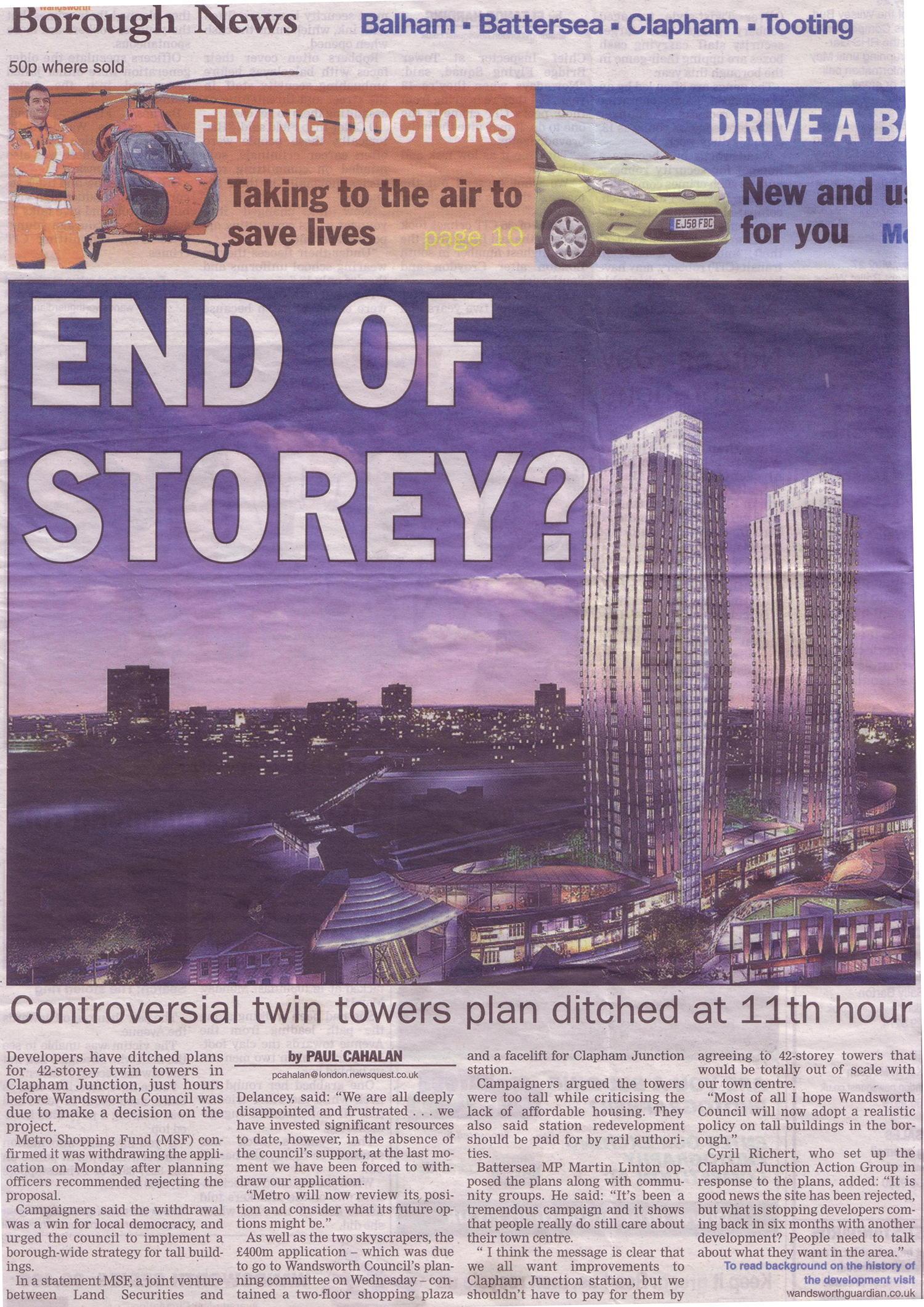Author: Julia Matcham
First, trying to sum up what has been going on regarding Clapham Junction development plans, one has to go back a bit to really understand the Council’s motivations. It is fairly boring to read the extracts from the Council’s Core Strategy Doc. (see at the bottom of this article for further explanation), but only by getting the idea of the dynamics which affect all Councils can one appreciate the impact of Section 106. (Click here to see description of possible agreements under the act as spelled out by lawyers offering their services, but if you Google Section 106 it will bring up this famously useful section as top of a long list of items on the subject).
Briefly, Section 106 is part of Planning Law by which the side effects of a given planning consent are paid for by the developer. For example a large development may have peripheral effects re-, for example, road relocations, road signs, re-plantations of trees, etc, and the legality of recompense, financial or in terms of works, for such events is built into Section 106.
While it sounds rational, it is easy to see that this act is open to abuse, effectively facilitating bribery and extortion depending on the participants desires to get what they want. It is hard to imagine that Councils do not bargain necessary local works to be implemented against planning consents granted or that developers of large projects don’t foresee a percentage of notional profit going to the Council for ‘this and that’ !
This is exactly what seems to be happening where the Ram Brewery (Wandsworth Town Centre) development is concerned, where the developers propose to deal with the current road bottleneck system in return for 11 tall buildings, two of which are actual tower blocks. It is also what is happening in the current (I think) stalemate between the developers of the Power Station Site and the Council where they are trying to bargain a huge tower against restoring the Power Station. Otherwise no go! What is strictly legal regarding this Acts highly flexible possibilities must be a very difficult to determine.
Effectively something similar is happening at the Junction. According to Metro Shopping Fund they can’t afford to renovate the Junction (under Section 106) unless they can have two tower blocks, which also suits the Council who are bent on solving their housing targets. It certainly seems strange that the Councils ‘Core Strategy Document’ quoted below makes little or no reference to Network Rail whose job it truly is to make CJ fit for use, but instead happily talks about the development of the Junction as an oncoming fact. The impression one gets from the document is that, but for Mark Hunter calling the developers to account, and ourselves making a boring fuss about ugly tower blocks being inappropriate, the Council would have quietly achieved its ‘London Plan’ (see below) housing objective, together with ‘improving’ the Junction, in one happy bit of rewarding three-way bartering, achieved, thanks to Metro Shopping, and Network Rail (happy to be co-operative in return for getting its work, which it swears it couldn’t afford, done for it!).
Unfortunately, the Council cannot help but be a thick-skinned beast trying to fulfill objectives handed down to them by others. In their need to do this, ugly things like tower blocks become ‘taller buildings’ which become ‘interesting landmarks’ . They simply find justifications for what they want.
I have to say that to me, reading the Core Strategy document, it looks as though the Council have had this development in mind, together with its presumed Section 106 benefits, for long before we got to know anything about it.
If we allow Section 106 to dictate deal after deal where Councils get their work done in return for planning permission for Tower Blocks our local landscape will be transformed into an ugly, unsociable, inhuman-in-scale, boring, environment!
Councils must do better than this when considering major developments. We need to see more than one way of developing the Junction, more than one style of architecture to imagine in place and a general plan which includes the good of the current community living in the buildings affected.
The Core Strategy Document is the Council’s Bible and although they write it themselves they have to take into account Government protocols.
The following are just the most relevant passages.
Incorporated into it is this information:-
The London Plan:
- Requires 7,450 new homes to be provided in Wandsworth over the period 2007/8 to 2016/17, with an annual target of 745. The Plan calls for 50% of all new homes in London to be affordable. Within this context, councils are to set their own targets to reflect local circumstances.
- Designates Vauxhall/Nine Elms/Battersea as an Opportunity Area, where mixed development is promoted to accommodate both new jobs and new homes.
- Identifies the town centres of Putney, Wandsworth, Clapham Junction and Tooting as Major Centres, and Balham as a District Centre, where retailing, services, employment, leisure and housing should be promoted along with opportunities for mixed development.
A bit further down is the line…
Seeks the promotion of tall buildings on suitable sites ….
So one gathers that the Council is doing what it is told …Again later it says:
There are redevelopment opportunities in Clapham Junction. The main issue here is how these opportunities could assist in providing the much needed redevelopment of the station.
No mention of Network Rails responsibilities!
Also from Core Strategy Doc.
Clapham Junction Station and adjoining sites
4.99 The station remains almost unchanged from its nineteenth century appearance.
Growing passenger numbers mean that its existing connections become cramped due to overcrowding. The increasing importance of Clapham Junction as an interchange warrants the creation of a station fit for the twenty-first century. It should have first class facilities for passengers, be inclusive in design, as well as being a quality civic building. The existing station approaches from the south and north offer a limited retail experience. The opportunity exists to re-structure the station approaches and provide an enhanced shopping area, together with a substantial residential and employment content. The good public transport connections to central London, Gatwick and Heathrow airports and south London and south-east England make the area a suitable location for high trip generating office development. Given the strategic importance of the station there may be justification for some taller buildings. These may help to reinforce and add visual significance to the town centre and a significant level of additional housing would make more efficient use of transport infrastructure, reducing dependency on car travel.
And then later …
The area may be suitable for taller buildings given the proximity to Clapham Junction Station. There is an opportunity to create a new urban public space of high quality. The Council considers there is potential for a Primary Care Centre to be located in Clapham Junction/north Battersea (see policy IS6 and supporting text).
And then later…
4.105 The Clapham Junction station proposals, as well as providing a modern accessible station, will offer potential to provide attractive modern shopping floorspace which should relieve pressure on the independent shops in Northcote Road, allowing this area to continue its specialist and complementary shopping role.
No mention of Network Rail. It is assumed that the developers will pay.














